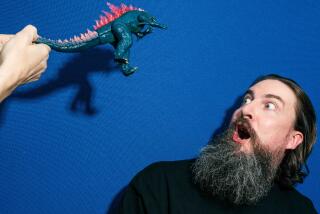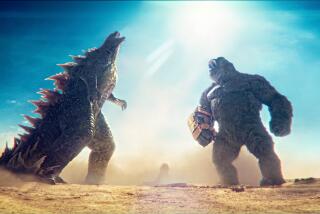HERO COMPLEX
- Share via
Hell hath no fury like an angry fanboy.
“Dragonball Evolution,” set to hit U.S. theaters today, is already reaching legendary status as the 2009 film fans love to hate, at least as far as the Internet is concerned. The makers of the live-action film hoped to tap into a built-in audience by adapting the hugely popular manga epic that had already spawned three anime series, 17 animated feature films and three television specials. Fans all over the world love “Dragon Ball,” but, well, it’s a thin line between love and hate.
Around the Web, fans have been bellowing their anger over the choices made by director James Wong (“The One,” “Final Destination”), who was to looking to streamline and mainstream the “Dragon Ball” mythology. It follows Goku, a monkey-tailed Japanese boy, while he trains in martial arts and searches for the seven Dragon Balls that are said to grant the wish of the beholder.
Fans are frothing on YouTube and elsewhere about the casting, missing characters, the fight scenes and even the hairstyles. This is serious stuff to devotees who have followed the manga franchise since it began in 1984 and have shown their allegiance by buying up the tie-in card game, the assorted video games, the apparel and other merchandise. On IMDb, the movie database website, one fan seemed to think a holy crime had been committed: “I could go on for hours about what they did wrong . . . may God have mercy on their souls.”
In the film’s defense
--
One of the film’s stars, Jamie Chung, who plays Chi Chi, is asking the fans to give it a chance by perhaps waiting until the movie reaches the screen before putting it in the same category as “Catwoman” or “Speed Racer,” two other Hollywood movies that took hand-drawn fanboy favorites and turned them into spectacular live-action bombs.
“I feel like all movies that adapt some sort of [material], whether it’s a book or a manga or a cartoon, into a film -- you’re going to have to take creative liberty in order to change it so that it works for a motion picture,” Chung said. “It’s never going to be the same, and you can’t satisfy everyone. What James Wong did was he adapted it in a way where it still stayed true to the ‘Dragon Ball’ series, with the essence of the characters,” said Chung, who is maybe best known for being one of the housemates in “The Real World: San Diego.”
At 20th Century Fox, the studio behind the “Dragonball” film, there must be some executives missing the old days when fans just waited for a movie to be released before deciding its fate. This is a new era of relationships between fans and studios. Warner Bros. had a muggle revolt last year when it abruptly postponed the sixth “Harry Potter” film from a November release to this summer to maximize profit; frustrated fans came after Warner chairman Alan Horn and pledged boycotts when the film reaches theaters. Fan debate also raged this year with the Warner film “Watchmen,” the Holy Grail of serious comic-book films, but unlike the old days when a controversy might propel a film for weeks at theaters, this time the movie generated more Internet traffic than box-office receipts. Second-week grosses plummeted 67%.
Chung, for one, has put full faith in Wong, whom she believes has made some controversial changes to make the film a bit more mainstream to new viewers.
They did what?
--
Some of the major “Dragonball” twists include setting the story to take place during Goku’s high school years, as well as casting a white actor in the role. But the biggest: What happened to Goku’s towering spikes? The hand-drawn Goku is instantly recognizable for his massive black spiked hair, which juts out as if he has an ebony agave plant growing from his head. Wong opted for a somewhat more mundane level of spikes for Justin Chatwin’s natural light-brown hair.
Chung, for one, said change is good sometimes. “I mean, you can’t make it look ridiculous,” the actress said. “When you’re doing close-up shots, and he’s wearing a 2-foot wig, it just looks ridiculous on film. It’s so different from something that’s from a cartoon to something on film. It’s a completely different world, and it was a huge challenge for James, and I feel like he really overcame.”
Chung also believes the cast was well chosen, even though they might not look like their traditional Japanese characters. The cast includes Emmy Rossum (“The Phantom of the Opera”) and Asian superstar Chow Yun-Fat (“Crouching Tiger, Hidden Dragon”).
Chung said there are plenty of reasons for fans to give Wong’s movie a chance, whether it’s the high-intensity action scenes (shot with a Phantom HD camera for frame rapidity that slows combat for a closer view) or the care given to make sure each character got its own fighting style (Chung’s Chi Chi, for instance, uses taekwondo, allowing her to “look pretty on the outside, but fight like a dude”).
In an unconventional move, “Dragonball” was released first in Asia (as early as March 12, 2008), and the film has done well despite bootleg copies hitting the market. The film passed the $22-million mark at the end of March, according to Box Office Mojo, and that was without any screenings in South America, North America or most of Europe.
The early reviews by non-believers have also been more kind; Variety’s Russell Edwards wrote of the film: “A popular Japanese manga series gets a pleasing if paint-by-numbers live-action makeover in ‘Dragonball Evolution,’ which halfheartedly tries to keep the faith for its pubescent male fan base.”
Chung said “Dragonball” is just beginning its fight to win over fans.
“No one wants to make a movie that people will hate,” Chung said. “We really want people to enjoy the movie for what it really is and to come in with an open mind and to understand where James Wong was trying to come from. Regardless of whether or not the fans will agree with it, they will be entertained.”
--
More to Read
The biggest entertainment stories
Get our big stories about Hollywood, film, television, music, arts, culture and more right in your inbox as soon as they publish.
You may occasionally receive promotional content from the Los Angeles Times.










